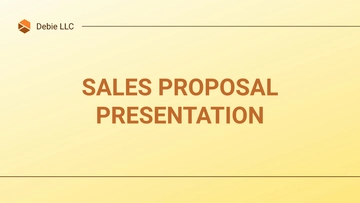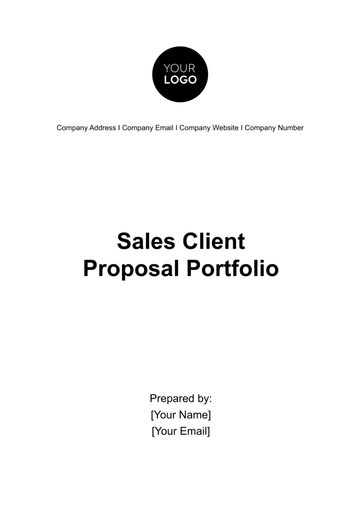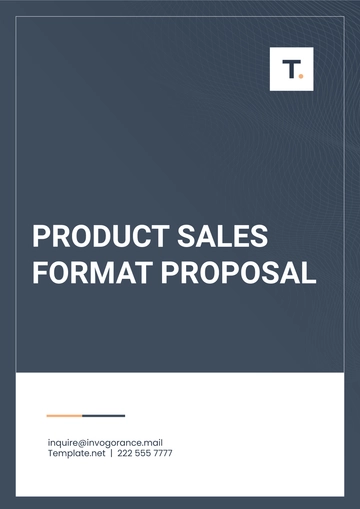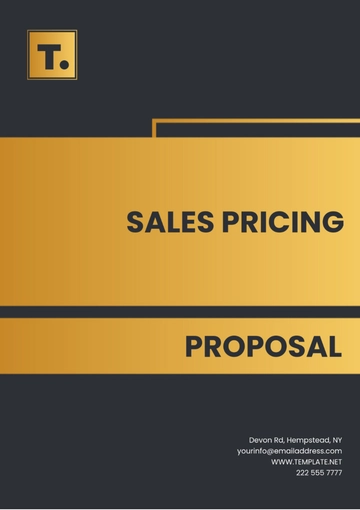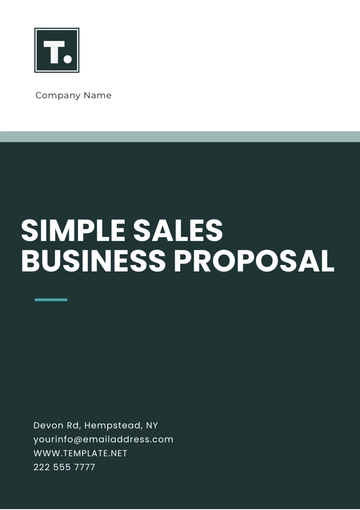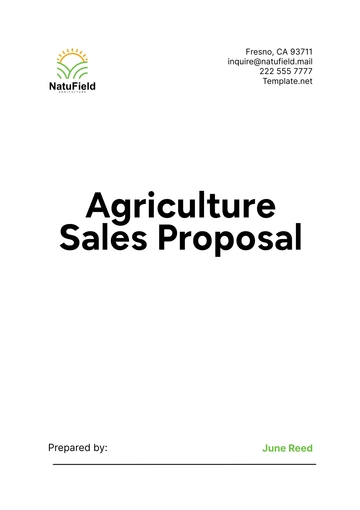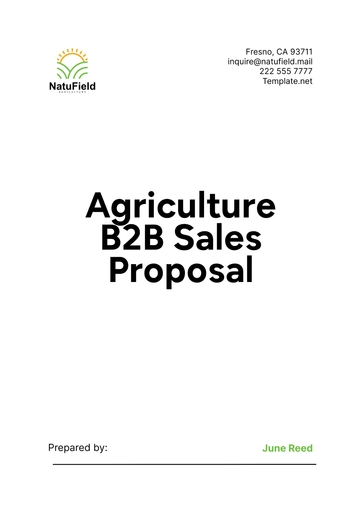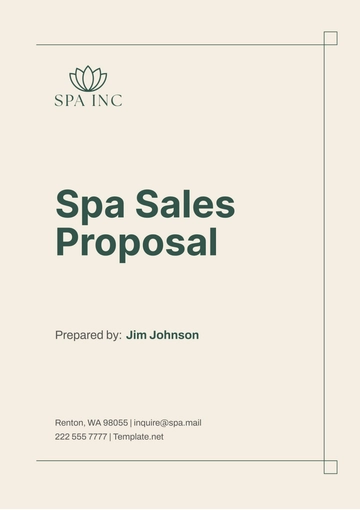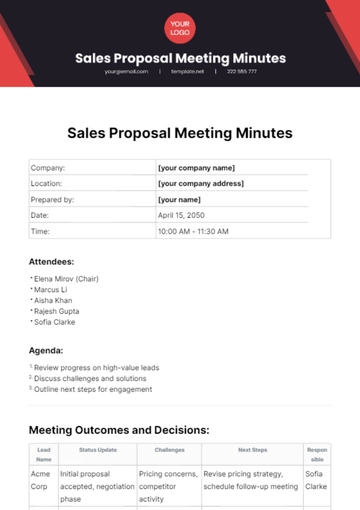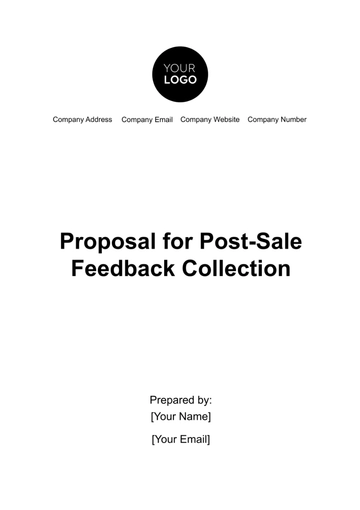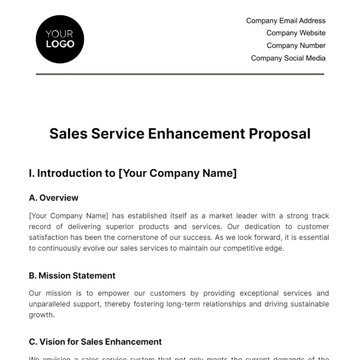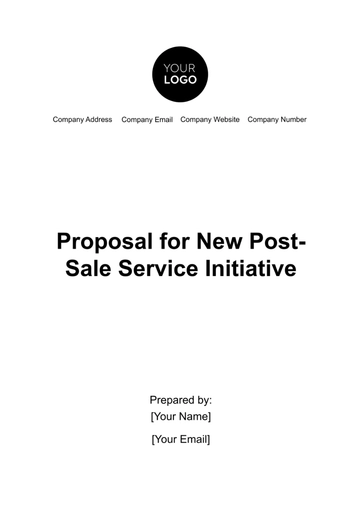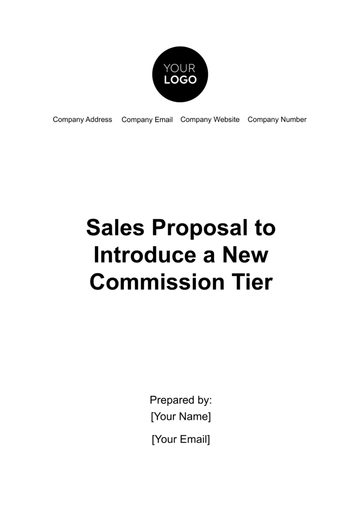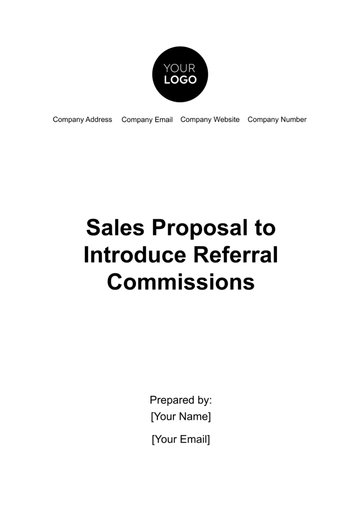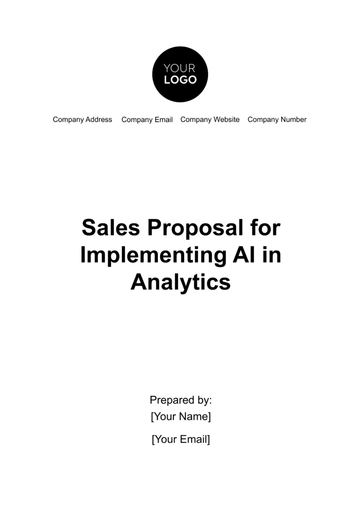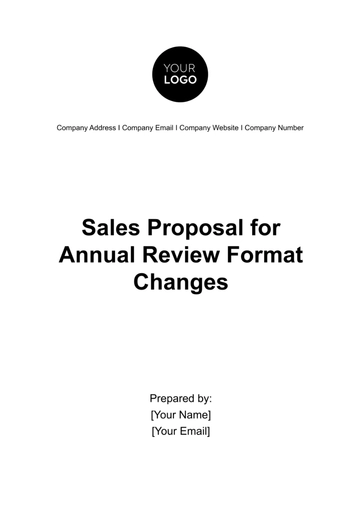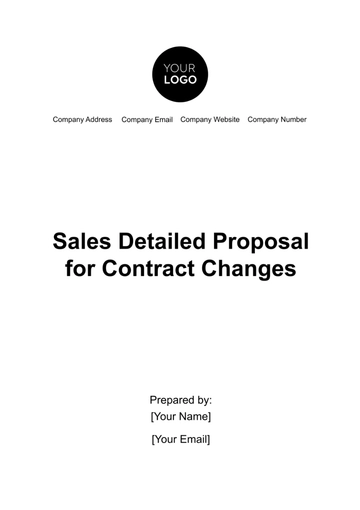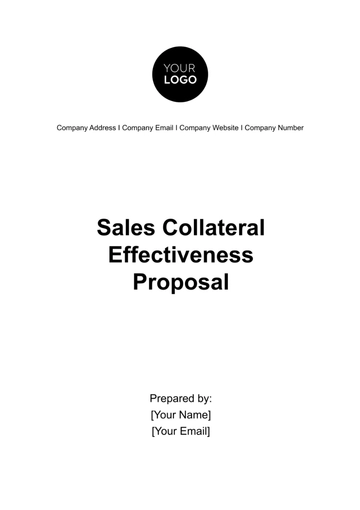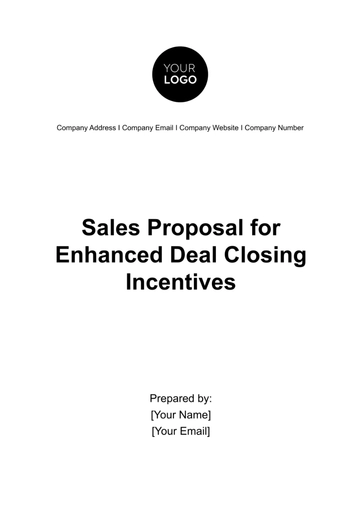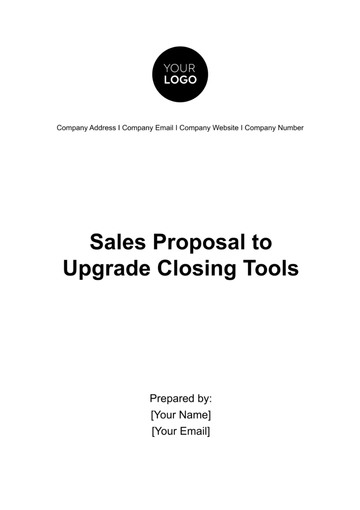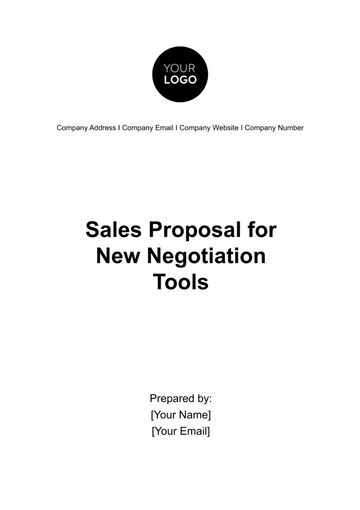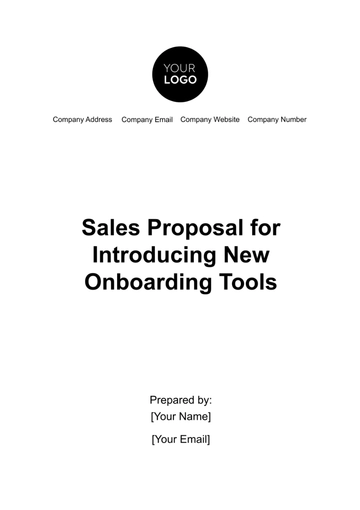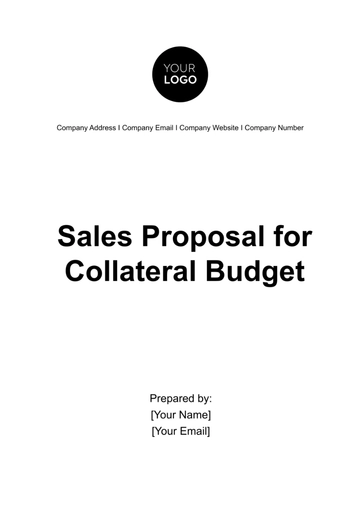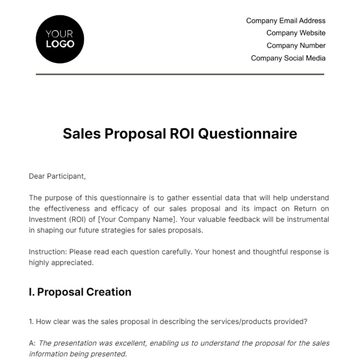Free Sales Key Account Proposal for Expansion
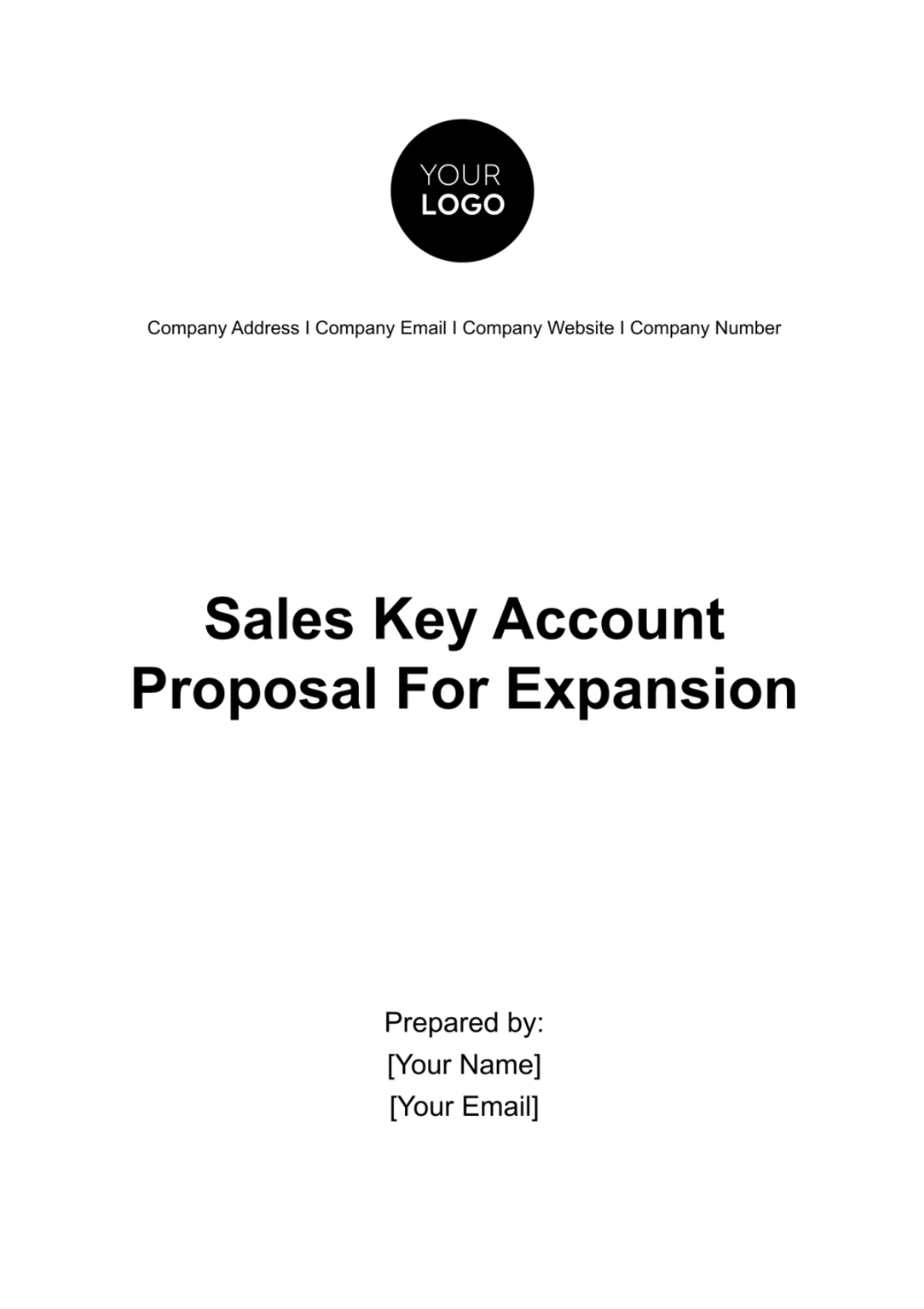
I. Executive Summary
Introduction
The introduction section serves as the opening statement of the proposal, providing context for the expansion plan. In this case, [Your Company Name] is thrilled to present this comprehensive Sales Key Account Proposal for Expansion to [Client's Name] of [Client's Company]. This proposal marks the beginning of an exciting journey to leverage [Your Company's] expertise and resources to drive growth and market expansion.
We understand that [Client's Company] has already established itself as a respected entity in the [Client's Industry]. Our proposal is founded on the belief that with the right strategies and a well-thought-out expansion plan, [Client's Company] can achieve new heights of success.
Proposal Objective
The primary objective of this proposal is to outline a strategic roadmap that will enable [Client's Company] to expand its reach and increase revenue streams. The specific goals of this proposal include:
Identifying target markets and demographics that align with [Client's Company]'s products/services.
Developing a compelling value proposition that sets [Client's Company] apart from competitors.
Creating detailed sales forecasts to provide a clear picture of the revenue potential.
Outlining an implementation plan, complete with resource allocation, a sales team structure, and a marketing strategy.
Presenting financial projections and ROI calculations to demonstrate the profitability of the expansion.
Conducting a thorough risk analysis and proposing mitigation strategies.
II. Current Business Overview
Client Background
This section delves into the background of [Client's Company], shedding light on its history, mission, and current position in the market. [Client's Company] has earned a reputation for excellence, with a track record of delivering high-quality products/services that meet the needs of its diverse clientele.
Our research into your company's history reveals that [Client's Company] was founded in [Year] by [Founder's Name] with a vision to "revolutionize the [Client's Industry] by providing innovative solutions that improve the lives of our customers." Since its inception, [Client's Company] has stayed true to this vision, earning the trust and loyalty of a growing customer base.
Market Analysis
It covers aspects such as market size, growth trends, and customer demographics. Our research team has gathered data indicating that the [Client's Industry] is currently experiencing steady growth, with a market size of approximately $[Amount] billion as of [Year].
Furthermore, we have identified specific trends in consumer behavior that suggest a growing demand for [Client's Company]'s products/services. With [Client's Company]'s solid reputation and the market's favorable conditions, the timing appears ideal for expansion.
Competitive Landscape
Understanding the competitive landscape is crucial. This section provides an overview of key competitors, their market share, and their strategies. [Client's Company]'s main competitors include [Competitor 1], [Competitor 2], and [Competitor 3]. Our research indicates that [Competitor 1] currently holds the largest market share at [00]%, primarily due to its extensive product line and strong brand presence. [Competitor 2] and [Competitor 3] follow closely behind, with market shares of [00]% and [00]% respectively. These figures illustrate the competitive nature of the industry.
Challenges and Opportunities
To succeed in any expansion endeavor, it's essential to acknowledge potential challenges and seize opportunities. We have identified several challenges and opportunities that are pertinent to [Client's Company]:
Challenges | Details |
|---|---|
Market Saturation: | Some segments of the market may be saturated, requiring innovative approaches to stand out. |
Regulatory Changes: | Changes in regulations could impact the industry; [Client's Company] must stay compliant. |
Supply Chain Risks: | External factors such as disruptions in the supply chain could affect operations. |
Opportunities | Details |
|---|---|
Technological Advancements: | Leveraging new technologies can enhance operations, leading to cost savings and improved product quality. |
Untapped Markets: | There are untapped markets [Client's Company] can explore, where market share is currently limited. |
Strategic Partnerships: | Collaborations with key partners can open doors to new markets and distribution channels. |
III. Proposed Expansion Strategy
Expansion Goals
Market Penetration: One of the primary goals is to increase market penetration in the target market by [00]% within the next 3 years. This means capturing a larger share of the existing market through strategic marketing and sales efforts.
New Market Entry: [Client's Company] intends to enter the new market, leveraging its core strengths, and achieve a market share of [00]% within the next [0] years.
Product Diversification: The strategy includes expanding [Client's Company]'s product portfolio by introducing [0] new products targeting the specific customer segments. These products are projected to contribute [00]% to the overall revenue within the next [0] years.
Target Market Analysis
Market Segmentation
The target market has been segmented into three categories:
Segment 1: Urban Professionals (00% of Target Market): These individuals are aged [00-00], have higher disposable incomes, and seek convenience and quality in products.
Segment 2: Suburban Families (00% of Target Market): Families with children aged 00-00], emphasizing value for money and family-friendly offerings.
Segment 3: Small Businesses (00% of Target Market): Small business owners looking for cost-effective solutions and personalized services.
Customer Personas
Customer personas have been created for each segment:
Persona 1: [Persona 1], the Urban Professional: Sarah values convenience and quality. She is willing to pay a premium for products that save her time.
Persona 2: [Persona 2], Suburban Residents: The Smiths prioritize affordability and seek family-oriented products.
Persona 3: [Persona 3], the Small Business Owner: David is cost-conscious and seeks tailored solutions for his business needs.
Market Size and Growth
The total addressable market (TAM) in their target market is estimated at $[Amount], with an expected annual growth rate of [0]% over the next [0] years.
Value Proposition
Unique Selling Points (USPs): [Client's Company] offers the following key USPs:
Cutting-Edge Technology: Our products leverage the latest technology, ensuring efficiency and effectiveness.
Personalized Service: We provide personalized solutions that cater to the unique needs of each customer segment.
Sustainability: [Client's Company] is committed to environmentally friendly practices, aligning with the values of today's conscious consumers.
Customer Benefits: [Client's Company]'s products/services offer tangible benefits to customers:
Time Savings: Our solutions save customers time, allowing them to focus on what matters most.
Cost Efficiency: [Client's Company] helps businesses reduce costs, increasing their profitability.
Environmental Impact: By choosing [Client's Company], customers contribute to a greener planet.
Sales Forecast
Monthly Sales Projections: Based on the strategies outlined, [Client's Company] can expect to achieve monthly sales of $[Amount] within the first year, with a steady increase thereafter.
Yearly Revenue Growth: Over the next [0] years, we anticipate annual revenue growth of [00]% on average, resulting in a projected revenue of $[Amount] by the end of Year 5.
Break-Even Analysis: [Client's Company] is projected to reach the break-even point within 10 months, demonstrating the viability of the expansion.
IV. Implementation Plan
Project Timeline
A detailed project timeline is essential to ensure that the expansion plan stays on track:
Phases | Details |
|---|---|
PHASE 1 | Market Research and Planning (Months January to April): During this phase, we will conduct in-depth market research, finalize the target market selection, and develop the marketing and sales strategies. |
PHASE 2 | Resource Allocation and Team Building (Months May to June): This phase involves allocating resources, including a budget of $[Amount], hiring personnel, and implementing necessary technologies. |
PHASE 3 | Marketing Campaign Launch (Month July): The marketing campaign will be launched, with a budget allocation of $[Amount] to create brand awareness and generate interest in [Client's Company]'s products/services. |
PHASE 4 | Sales Implementation (Months August to December): The sales team will execute the strategies, targeting potential clients and closing deals. |
Resource Allocation
Budget Allocation: An estimated budget of $[Amount] has been allocated for the entire expansion project. This includes marketing expenses ($[Amount]), sales team salaries ($[Amount]), technology investments ($[Amount]), and other operational costs.
Personnel: Key personnel have been identified for various roles, including a Sales Manager, Marketing Manager, and Sales Representatives. Salaries and benefits for the team amount to $[Amount] annually.
Sales Team Structure
Sales Team Roles: The sales team includes [Number] Sales Representatives responsible for lead generation and closing deals, with a Sales Manager providing guidance and oversight.
Training: A comprehensive training program, costing $[Amount], will be conducted to ensure that the sales team is well-equipped to meet the demands of the target markets.
Marketing Strategy
Digital Marketing: The plan includes a robust digital marketing strategy, with a budget of $[Amount]. This includes social media advertising, content marketing, and email campaigns aimed at reaching and engaging with the target audience.
Traditional Marketing: In addition to digital efforts, traditional marketing channels such as print media and participation in industry trade shows will be utilized, with a budget allocation of $[Amount].
V. Financial Projections
Revenue Projections
Year | Details |
|---|---|
YEAR 1 | In the first year of the expansion, we anticipate total revenue of $[Amount]. This projection is based on the initial market penetration phase, where sales efforts are ramped up to capture market share. |
YEAR 2 | The second year is expected to see substantial growth, with projected revenue of $[Amount]. This growth is driven by the continued market expansion and the introduction of new products to the portfolio. |
YEAR 3 | By the third year, revenue is projected to reach $[Amount]. This growth reflects the maturing of the market and the increasing loyalty of customers who appreciate the value [Client's Company] provides. |
YEAR 4 | Year four is estimated to generate revenue of $[Amount]. This steady growth is in line with the market's growth rate, and [Client's Company] continues to innovate and maintain a competitive edge. |
YEAR 5 | By the end of Year 5, revenue is projected to reach $[Amount]. This growth is a testament to the effectiveness of the expansion strategies and [Client's Company]'s strong position in the market. |
Cost Analysis
Yearly Operating Costs: The yearly operating costs for the expansion include personnel salaries ($[Amount], marketing expenses ($[Amount]), technology investments ($[Amount]), and other operational costs ($[Amount]). The total yearly operating costs amount to $[Amount].
Cost of Goods Sold (COGS): The COGS is estimated at [00]% of revenue, resulting in a cost of $[Amount] for Year 1, which scales proportionally with revenue growth in subsequent years.
Gross Profit Margins: The gross profit margins for the first year are projected to be [00]%, with a gradual increase to [00]% by Year 5, demonstrating improved operational efficiency and cost management.
Return on Investment (ROI)
Year [1] ROI: In the first year, the ROI is projected to be [00]%, indicating that for every $[Amount]invested in the expansion, [Client's Company] can expect to earn $[Amount].
Year [5] ROI: By the end of Year 5, the ROI is projected to increase to [00]%, illustrating the long-term profitability and sustainability of the expansion efforts.
VI. Risk Analysis
Identification of Risks
Market Saturation Risk: As [Client's Company] seeks to penetrate new markets, there is a risk of market saturation, particularly in mature segments. Mitigation: Continuous market research and product innovation to maintain a competitive edge.
Regulatory Changes: Changes in industry regulations can impact operations. Mitigation: Staying informed about regulatory updates and adjusting strategies accordingly.
Supply Chain Risks: External factors such as disruptions in the supply chain can affect operations. Mitigation: Diversifying suppliers and implementing contingency plans.
Risk Mitigation Strategies
Market Saturation Mitigation: [Client's Company] will focus on diversifying its product offerings and exploring niche markets that may be less saturated. Continuous customer feedback will drive product improvements.
Regulatory Compliance: [Client's Company] will establish a dedicated regulatory compliance team to monitor and ensure adherence to changing regulations. Regular training for employees will also be conducted.
Supply Chain Risk Mitigation: [Client's Company] will maintain strategic stockpiles of critical components and materials and establish alternative supply sources to mitigate supply chain disruptions.
VII. Conclusion
The Sales Key Account Proposal for Expansion presented here outlines a robust and well-researched strategy for [Client's Company] to achieve its expansion goals. The thorough market analysis, clear value proposition, and detailed financial projections all point toward a promising future.
[Your Company Name] is committed to partnering with [Client's Company] on this exciting journey, leveraging our expertise and resources to drive growth and success. We believe that by working together, we can not only meet but exceed the outlined goals.
- 100% Customizable, free editor
- Access 1 Million+ Templates, photo’s & graphics
- Download or share as a template
- Click and replace photos, graphics, text, backgrounds
- Resize, crop, AI write & more
- Access advanced editor
Plan the expansion of your key accounts with our Sales Key Account Proposal for Expansion Template from Template.net. This structured template offers an editable and customizable format for creating a proposal to expand your key account relationships. It includes sections for outlining the current situation, proposing expansion opportunities, and presenting the benefits of expansion. Edit this template using our Ai Editor Tool to strategically grow your key accounts and increase revenue.
You may also like
- Business Proposal
- Research Proposal
- Proposal Request
- Project Proposal
- Grant Proposal
- Photography Proposal
- Job Proposal
- Budget Proposal
- Marketing Proposal
- Branding Proposal
- Advertising Proposal
- Sales Proposal
- Startup Proposal
- Event Proposal
- Creative Proposal
- Restaurant Proposal
- Blank Proposal
- One Page Proposal
- Proposal Report
- IT Proposal
- Non Profit Proposal
- Training Proposal
- Construction Proposal
- School Proposal
- Cleaning Proposal
- Contract Proposal
- HR Proposal
- Travel Agency Proposal
- Small Business Proposal
- Investment Proposal
- Bid Proposal
- Retail Business Proposal
- Sponsorship Proposal
- Academic Proposal
- Partnership Proposal
- Work Proposal
- Agency Proposal
- University Proposal
- Accounting Proposal
- Real Estate Proposal
- Hotel Proposal
- Product Proposal
- Advertising Agency Proposal
- Development Proposal
- Loan Proposal
- Website Proposal
- Nursing Home Proposal
- Financial Proposal
- Salon Proposal
- Freelancer Proposal
- Funding Proposal
- Work from Home Proposal
- Company Proposal
- Consulting Proposal
- Educational Proposal
- Construction Bid Proposal
- Interior Design Proposal
- New Product Proposal
- Sports Proposal
- Corporate Proposal
- Food Proposal
- Property Proposal
- Maintenance Proposal
- Purchase Proposal
- Rental Proposal
- Recruitment Proposal
- Social Media Proposal
- Travel Proposal
- Trip Proposal
- Software Proposal
- Conference Proposal
- Graphic Design Proposal
- Law Firm Proposal
- Medical Proposal
- Music Proposal
- Pricing Proposal
- SEO Proposal
- Strategy Proposal
- Technical Proposal
- Coaching Proposal
- Ecommerce Proposal
- Fundraising Proposal
- Landscaping Proposal
- Charity Proposal
- Contractor Proposal
- Exhibition Proposal
- Art Proposal
- Mobile Proposal
- Equipment Proposal
- Student Proposal
- Engineering Proposal
- Business Proposal

